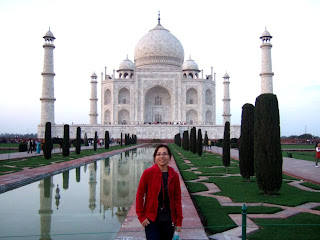
Agra is a city on the banks of Yamuna River in the northern state of Uttar Pradesh, India. It was the capital of Mughal emperors for 132 years (1526-1658) and remains a major tourist destination because of its many splendid Mughal-era buildings. The most notable and have been included into UNESCO world heritage sites are Taj Mahal, Agra Fort and Fatehpur Sikri. The roads in Agra were shabby and narrow and traffic was appalling but this dingy and air polluted dusty city attracts millions of tourists from all parts over the world for only one destination one reason, to eye witness the sheer majestic buildings and remaining site of Mughal kingdom and its legends.



While entering through the narrow archway into the southern hall of Taj Mahal, all visitors were required to gone pass a very tight security check.



This massive arched gateway topped with delicate domes and adorned with Koranic verses was the original entrance of Taj Mahal. The west side building parallel to the wall is the mosque of the monument and on the east was a building named as Jawab, most probably was a guesthouse.



Apart from the front side facing Yamuna River was left opened, three other sides of Taj Mahal were walled up by red sandstone with two buildings parallel to the wall.


Taj Mahal attracts millions of visitors a year including those coming from other parts of India. It was recorded that during festive season, the number of visitors were exceeding 50 thousand a day.



Chowk-I-Jilo Khana is the red sandstone forecourt at southern end allowing people to approach The Taj. This is the only existing entrance for visitors.


Taj Mahal is the symbol of love and eternity. It was built in 1631 by The Moghal Emperor Shah Jahan in memory of his 2nd wife Mumtaz Mahal who died after giving birth to their 14th child.



Mumtaz Mahal was the daughter of Emperor Jahangir's brother-in-law and before she was bestowed with name Mumtaz Mahal, she was called Arjumand Banu. Shah Jahan was then Prince Khuram and fell in love in her beauty at first sight. He proposed for her hand on the next day they met but married 5 years later as per advice given by astrologers. It was a grand ceremony in their wedding in 1612 and they had 14 children within 19 years of marriage, but half of them died in infancy.




Mumtaz Mahal was generous and full of compassion and always acted as a petitioner to assist the poor and aged people. She used to follow her husband in his expedition. In year 1630, she died in child birth at Deccan where Shah Jahan was on the way to war with Khan Jahanbi Lodhi. Her death was a great blow to Emperor Shah Jahan. The entire kingdom went into mourning for two years without any celebrations.


Mumtaz Mahal extracted 4 promises from Shah Jahan before she died that (1) to build a Taj for her (2) to marry again (3) to be kind to their children and (4) to visit her tomb on her death anniversary date.


Shah Jahan hired and engaged skilled architects, inlay craftsmen, calligraphers, stone-carvers and masons from places as far as Persia and Turkey using materials brought back by more than 1000 elephants from all parts of India. It took 20 years and 20 thousand pairs of hands, with hard labor in sweat, to turn this ambitious project of a crazy lover on the theme of love into reality and eternity. It was said that hands of those who involved in the construction were chopped off to make sure that no one else could create similar type of architecture.


Taj Mahal is renowned for its architectural magnificence and aesthetic beauty. It is one of the most spectacular buildings of the world. As a tomb, this magical creation of Shah Jahan till today has no match on earth.



Taj Mahal is pinkish in the morning, milky white in the evening and golden color when moon shines.













Appeared in two entirely different faces in daytime and towards evening hour.





Various appearance of Taj at different angle.





Taj Mahal was topped with a huge central dome with 99 different names of Muslim God adorned the top of Mumtaz Mahal tomb. It is essentially square in shape with peaked arches cutting into the sides. Fine relief carving highlighted by floral patterns of precious stone.



The little cenotaph of Mumtax Mahal was placed at the center of the dome while Shah Jahan's by her side. The cenotaph were representing the real coffins which lied in the same position in an unadorned and humid crypt below with scent of incense and rose petals. The crazy lover Shah Jahan finally lied side by side with his beloved wife Mumtaz Mahal ever forever.



The marble screen was so finely cut and decorated with precious stones look almost translucent and when illuminated with torches, the decorations scattered out dappled light over cenotaph of the two lovers.




The best hour to witness and admire the beauty of Taj is during sun-rise or sun set. The Red sandstone Masjid Building at the western side of Taj glittering under the sun-setting beam.


Taj Mahal located on the bank of Yamuna River, un-shadowed without blocking from any structure and also could be seen clearly from Shah Jahan's Palace at Agra Fort. Wild life enjoyed breeding and lovers enjoyed canoeing in the flow of romantic Yamuna River in front of The Monument.



A sherbet seller outside Taj Mahal and shoes storing service place inside the building, as all visitors are not allowed to wear shoes into the Taj, just like most of the other religious site and buildings.

